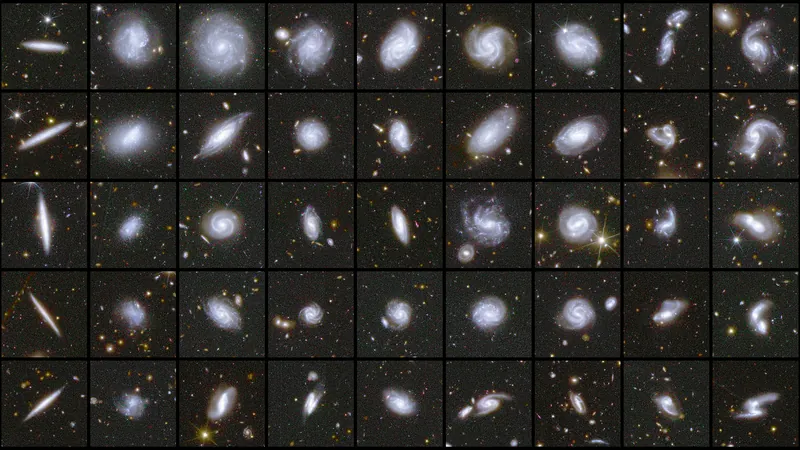
Massive Discovery: 26 Million Galaxies Unveiled in Just One Week by ESA’s Euclid Mission!
2025-03-26
Author: Lok
Massive Discovery: 26 Million Galaxies Unveiled in Just One Week by ESA’s Euclid Mission!
The European Space Agency (ESA) has electrified the astronomical community with its groundbreaking findings from the Euclid mission. The initial release of survey data reveals stunning deep-field images that showcase an astounding collection of galaxies and clusters, setting the stage for one of the largest cosmic maps ever created.
In the span of just one week, Euclid meticulously mapped an impressive 63 square degrees of galaxy-rich skies—an area equivalent to 300 full Moons. This ambitious effort resulted in the capture of over 26 million galaxies, including distant quasars located a staggering 10.5 billion light-years away. With plans to conduct scanning of these regions up to 52 times before 2030, the final sky map will span a remarkable 14,000 square degrees, or one-third of the celestial sphere.
These images not only provide a breathtaking visual of the cosmic web but also offer vital insights into the unseen forces that govern our universe. Each observation presents intricate details of active galactic nuclei and fleeting celestial phenomena, hinting at the fundamental principles shaping the cosmos.
Revealing the Structure of the Universe
Euclid’s observations are a game-changer in our understanding of the universe's large-scale structure. The mission utilizes advanced visible and near-infrared instruments to meticulously measure the shapes and distances of galaxies, essentially revealing the filamental structure of both normal and dark matter cascading throughout space. This web-like framework represents the birthplaces and evolving realms of galaxies.
"We are unlocking a treasure trove of information for scientists to dive into," stated Professor Carole Mundell, director of science at ESA. With the rise of dark matter and dark energy—comprising an astounding 95% of the universe—these observations are pivotal.
Harnessing AI to Decode Cosmic Mysteries
With the deluge of data—around 100 GB daily—scientists are innovating fresh strategies to process and analyze it. A new catalogue featuring over 380,000 galaxies classified by their shapes and features has emerged, aided by artificial intelligence models and enthusiastic citizen scientists.
Mike Walmsley, a scientist associated with the Euclid Consortium, emphasized the essential role AI plays in categorizing these galaxies. A standout effort, the Zoobot algorithm, trained by nearly 10,000 volunteers, is now proficient at identifying traits such as spiral arms and galactic mergers, capturing just a fraction (0.4%) of what Euclid will eventually reveal.
Unlocking Dark Matter with Gravitational Lensing
A significant aspect of the Euclid mission involves understanding gravitational lensing—the phenomenon where light from distant galaxies bends due to the gravitational pull of intervening matter. This natural effect allows scientists to uncover dark matter, which eludes direct observation.
Thanks to AI and human collaboration, Euclid has already identified 500 potential strong gravitational lenses, with expectations of discovering up to 100,000 by mission’s end, vastly increasing the current known quantity. These gravitational lenses provide a critical tool for mapping the distribution of dark matter across the universe, including how it shapes galaxies.
What Lies Ahead for the Euclid Mission?
By March 2025, Euclid is expected to have scanned approximately 2,000 square degrees of galaxy-laden sky, initiating the ambitious task of mapping the universe like never before. The first complete set of cosmological data is slated for release in October 2026, providing researchers with deep insights and highly detailed views of selected cosmic regions.
Launched in July 2023, Euclid commenced its science operations in February 2024. Developed by ESA with contributions from NASA and prominent aerospace companies like Thales Alenia Space and Airbus, the mission boasts the support of the Euclid Consortium, comprising over 2,000 scientists across 15 countries.
Interested readers can explore the first deep field images via the ESA’s ESASky platform. This spectacular revelation marks just the beginning of Euclid’s journey to unveil the intricate and hidden structures of our vast cosmos.
Stay tuned as we continue to delight in the discoveries that await us in the depths of space!


 Brasil (PT)
Brasil (PT)
 Canada (EN)
Canada (EN)
 Chile (ES)
Chile (ES)
 Česko (CS)
Česko (CS)
 대한민국 (KO)
대한민국 (KO)
 España (ES)
España (ES)
 France (FR)
France (FR)
 Hong Kong (EN)
Hong Kong (EN)
 Italia (IT)
Italia (IT)
 日本 (JA)
日本 (JA)
 Magyarország (HU)
Magyarország (HU)
 Norge (NO)
Norge (NO)
 Polska (PL)
Polska (PL)
 Schweiz (DE)
Schweiz (DE)
 Singapore (EN)
Singapore (EN)
 Sverige (SV)
Sverige (SV)
 Suomi (FI)
Suomi (FI)
 Türkiye (TR)
Türkiye (TR)
 الإمارات العربية المتحدة (AR)
الإمارات العربية المتحدة (AR)